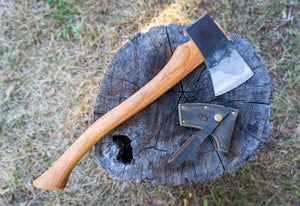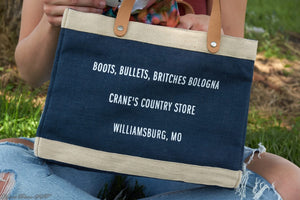
How to Choose the Right Pocket Knife
Pocket knives have been used for thousands of years, making their first known appearance in 600 BC. The pocket knife we know and love has come a long way since then. Today, it’s the trusty tool found in everyone’s back pocket.
From handle material to blade style, the possibilities for your next pocket knife are endless. With a myriad of options, it can be difficult to decide what kind of pocket knife you need.
The next time you need to cut, saw or slice make sure you have the best pocket knife for the job. Find the right knife with this pocket knife guide.

Types of Pocket Knives
Pocket knives vary by number of blades, blade style, handle material and more. How you plan to use your knife will help determine what kind of knife to get.
- Single-blade pocket knife. A traditional pocket knife is a plain, single-blade knife. If you need something simple and usable for most purposes, a single-blade will likely do you just fine. Since it only has one blade, often the blade is larger and sturdier on a single-blade knife.
- Multi-blade pocket knife. As the name states, multi-blades offer two to four blades in one pocket knife. If you need more blade variation but don’t want to haul around multiple knives, a multi-blade pocket knife may be right for you.
- Multi-tool pocket knife. For those who need even more variety, a multi-tool pocket knife adds value by including tools like tweezers, nail files, scissors, can openers and more. Think of a classic Swiss Army knife—it’s the original multi-tool. These knives are great to take camping and hiking.
What Size Do You Need?
Small pocket knives are easier to carry around, but they are not as strong as larger blades. Blades anywhere from 2.75” to 4” can be effective for a variety of purposes while still being relatively easy to take along. Keep in mind that larger blades, like those over 4”, may not be legal to carry, making them impractical for everyday use.
How Will You Carry Your Knife?
Fixed blade or folding pocket knife? If you want something to store comfortably in your pocket, you’ll want a folding pocket knife. Folding knives are smaller and easier to tote around, making them the best knives for long hikes, backpacking trips or everyday use.
Some folding knives are manual, meaning you have to pull the blade out yourself. Many use a stud or notch to allow you to open the knife with one hand. Assisted opening knives are also available. With these knives, a mechanism opens the knife for you. Of course, each assisted opening knife includes a safety lock to prevent the knife from opening by accident.
There is a caveat to folding pocket knives. If the knife is non-locking, there is a risk the blade could come down on your fingers during use. With a fixed blade pocket knife, you won’t have to worry about any accidental folding.
Many hunting knives are fixed blades because they tend to be stronger than folding knives. If you need to skin an animal or cut through thick materials, fixed blade pocket knives can handle more pressure. The downside to fixed blades is that they are typically larger and require a sheath, making them less convenient to carry.
Choose Your Blade
Once you know more about what kind of knife you want, it’s time to explore what type and style of blade suits you. Some blade types are better for cutting and slicing, while others are better for sawing or piercing material.
Blade Type
- Plain. Knives with plain blades allow for more control and better accuracy. Plain blades are good for pushing through materials and leaving clean cuts.
- Serrated. If sawing is your goal, a serrated blade works to saw through tough material. The cuts from a serrated knife will be jagged, so if you’re looking for clean cuts serrated blades aren’t the answer.
- Partially serrated. For the best of both worlds, a partially serrated blade may be the ticket. Typically, the belly of the blade will be plain and the edge closest to the kick will be serrated.
Blade Style
These are just a few of the blade styles available. There are many more styles on the market, so you’re sure to find the one that meets your needs.
- Clip point. Do you need a good hunting knife or a knife you can use every day? If you need a pocket knife for piercing and slicing, a clip point blade style has a back with a curve—almost like a piece of the blade has been “clipped” off—for a sharper point.
- Tanto. Looking for a strong blade that can get through tough materials? Chisel-like in nature, a tanto style blade works well for pushing through thick materials with its angular point. It’s also great for scraping away material.
- Drop point. With a drop point blade, you’ll have a pocket knife good for almost every occasion. This style of blade is easy to control, making it perfect for skinning and piercing. It’s the knife you’ll want to take hunting.
- Straight back. This style of blade is found on many traditional pocket knives. With a straight spine and slight curve on the blade, a straight back knife works best for chopping and slicing.
- Hawksbill. True to its name, the hawksbill style blade looks like the beak of a predatory bird. From opening boxes to splitting cords, this style of blade is perfect for cutting.
- Sheepsfoot. With its straight edge, a sheepsfoot blade was made for cutting and chopping. On your next camping trip, don’t forget to pack this pocket knife!
Pick Your Materials
Whether it's a folding pocket knife or a fixed blade, pocket knives can be made of stainless steel or high carbon steel. As you shop for pocket knives, keep the edge retention and corrosion resistance of each blade in mind.
High carbon steel knives have more carbon in the blade, making them stronger. Knives with high carbon steel can handle pressure and are resistant against regular wear and tear. They tend to stay sharper longer than stainless steel knives. However, these blades are more vulnerable to rust and corrosion.
For better resistance against corrosion, stainless steel pocket knives are your best bet. Stainless steel is made with more chromium, which protects the knife from corrosion. If you’ll be using your knife outdoors and in the elements, you may want to consider stainless steel. There are many grades of stainless steel knives. Those with more chromium will be more durable and more expensive.
Crane’s Country Store
At Crane’s Country Store, we have a wide selection of some of the best pocket knife brands out there: Case, Benchmade and Browning.
Explore our Benchmade Knives, Case carbon steel knives, Case hunting knives and more here.









